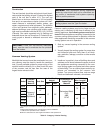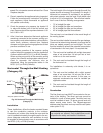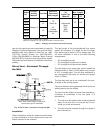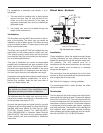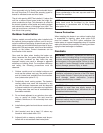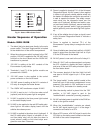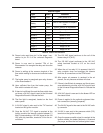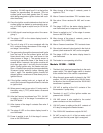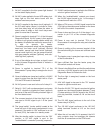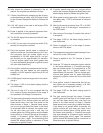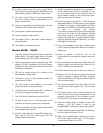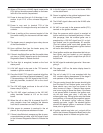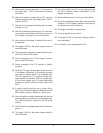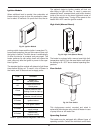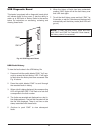
37
9. 24 VAC is applied to the blue power light located
on the status display board.
10. 24 VAC is also applied to the red LED safety shut-
down light on the front status board until the
safeties have been proven.
11. 24 VAC is applied to the alarm circuit (optional). If
the E-5 sales option (Alarm) is included a 5-sec-
ond time delay relay will not allow the alarm to
sound unless a safety or limit circuit stays ener-
gized for more than 5 seconds.
12. Power is applied to terminal P1-1 of the Universal
Diagnostics Board. 24 VAC power is then applied
in series to all typically closed safeties wired into
the heater. All safeties are verified to ensure that it
is safe to operate the heater.
The safety components wired into the diagnostic
board are: low water cut-off (optional), blocked
vent switch, manual vent temp switch (optional),
manual reset high limit, low gas pressure switch,
high gas pressure switches (optional), and auto-
reset high limit (optional).
13. If any of the safeties do not close, a signal is sent
to the Universal Diagnostics Board to indicate a
safety fault.
14. Power is applied to terminal TP-1 of the
Economaster II pump delay to energize the circuit
board.
15. Once all safeties are closed and verified, a 24 VAC
signal is output from the Auto High Limit to J5 pin
3 of the CPW board of the heater.
16. 24 VAC power is now sent to the coil of relay K-1.
17. Relay K-1 (N.C.) will now be energized, and opens
the N.C. contacts to disable the alarm (optional)
and turns off the red LED safety shutdown light on
the front status board.
18. The common terminal of the Auto High Limit will
now send a 24 VAC signal to pin 1 of the “panel
switch”.
19. The “panel switch” (rocker switch) located at the
lower left front of the control compartment is now
powered. If the switch is “ON” and there is no call
for heat (CFH), the heater is in standby mode.
20. After the standby switch is placed into the “ON”
position, a 24 VAC signal is sent to the
“enable/disable” connection (normally jumpered).
21. 24 VAC switched power is applied to the S24V ter-
minal on ignition modules 1 and 2.
22. When the “enable/disable” contacts are closed,
the 24 VAC signal travels to pin 1 of the stage 1
connection and waits for a CFH.
23. When a CFH occurs, a 24 VAC signal is sent to the
CFH light on the status panel located on the lower
left front of the control compartment.
24. Power is also sent from pin 2 of the stage 1 con-
nection to pin P1-3 of the universal diagnostic
board.
25. Power is now sent to terminal TP4 of the
Economaster II to energize the relay and close the
contacts.
26. Power is waiting at the common terminal of the
flow switch waiting for closure and sufficient water
flow.
27. The heater pump is energized upon relay closure
of the Economaster II.
28. Upon sufficient flow from the heater pump, the
flow switch contacts will close.
29. If there is insufficient flow and the flow switch does
not close, a 24 VAC signal is sent to the Universal
Diagnostics Board to indicate the fault.
30. The flow light is energized; located on the front
status panel.
31. A 24 VAC signal is also sent to the “TH” terminal
located on ignition module one.
32. Once the 24 VAC “TH” signal is received at ignition
module one, the internal contacts between F1 and
F2 close sending a 120 VAC signal to the 120 VAC
pilot duty terminals, located at J14 on the circuit
board.
33. The 120 VAC signal continues to the coil of the
blower relay K-4 (N.O.).
34. The 120 VAC signal continues to the 120 VAC
safety terminals located at J13 on the circuit
board.
35. When the coil on relay K-4 is powered, the N.O.
relay contacts close and energize the blowers
from the J8 connections on the CPW board.



